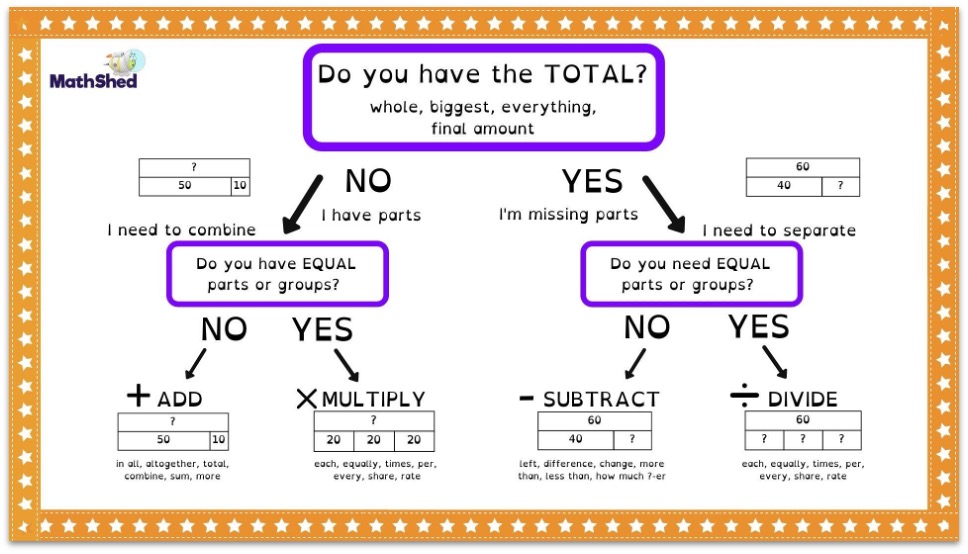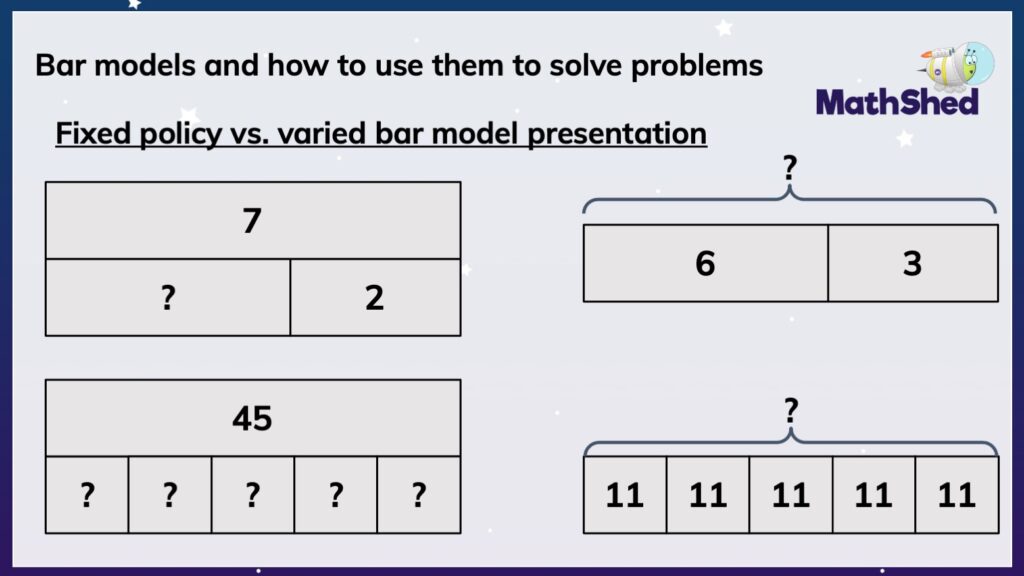Boost analytical skills with consistent practice of bar model drawing techniques
Wiki Article
Exploring Bar Model Drawing Techniques: A Comprehensive Overview to Imagining Math Concepts
Bar design attracting techniques serve as a valuable source for both educators and pupils in envisioning mathematical principles. These designs simplify intricate numerical connections, aiding in the understanding of enhancement, reproduction, division, and subtraction. This overview outlines efficient strategies for carrying out bar versions, fostering active interaction and real-world links. As visitors discover the sensible applications and mentor tips, they will certainly discover just how these techniques can change their method to mathematics.Understanding the Basics of Bar Model Drawing
Bar design attracting functions as a powerful visual tool in maths, facilitating the understanding of numerical connections and analytic strategies. This method entails representing numbers and their connections via rectangular bars, making it easier to envision operations such as enhancement, department, reduction, and reproduction. Each bar's size corresponds to a particular value, permitting students to compare amounts and comprehend percentages clearly.To produce a bar design, one begins by determining the issue's key elements, typically simplifying into parts that can be aesthetically represented. In a straightforward addition trouble, 2 bars can be attracted, with their sizes representing the addends. The mixed size shows the sum. In enhancement, bar models can be adjusted for more intricate problems, consisting of ratios and portions, by adjusting benches accordingly. Understanding these essentials lays a solid foundation for reliable analytic and deeper mathematical understanding.
Benefits of Utilizing Bar Models in Mathematics
Making use of bar models in mathematics supplies various benefits that enhance learning and understanding. These visual representations help trainees in realizing intricate ideas by damaging them down into convenient components. Bar models supply a clear framework for showing partnerships between numbers, making abstract concepts more concrete. They advertise a much deeper understanding of mathematical operations and help with problem-solving by enabling learners to picture the data they are collaborating with.Furthermore, bar models sustain the development of important believing abilities, as students need to examine and translate the aesthetic info to draw conclusions. This method urges energetic involvement with the product, enhancing retention and proficiency of mathematical concepts. By promoting a strong foundation in visual proficiency, bar designs equip students to approach various mathematical challenges with confidence. On the whole, the assimilation of bar models into mathematics education shows beneficial in growing both understanding and analytical capacities among trainees.
Applying Bar Designs to Enhancement and Reduction
Bar models act as an effective device for visually standing for addition and reduction troubles. By highlighting the partnership in between numbers, they improve understanding and facilitate analytical. Furthermore, real-life applications of these models can assist students understand mathematical ideas in functional contexts.Representing Enhancement Aesthetically
Aesthetic help can significantly improve their understanding of these procedures when trainees come across enhancement and subtraction problems. Bar models work as reliable devices for standing for addition. By dividing a rectangular shape right into segments that represent the numbers entailed, students can envision the partnership in between the amounts. If a student requires to include 3 and 5, they can create a bar separated into 2 areas: one area representing 3 and the other representing 5. This clear representation not just simplifies the enhancement procedure yet additionally strengthens the idea of incorporating amounts. As students adjust these aesthetic aids, they create a much deeper understanding of enhancement, bring about enhanced problem-solving skills and better self-confidence in their mathematical capacities.
Reduction With Bar Models
Reduction is usually perceived as an extra complex operation than addition, bar designs can efficiently clarify this procedure for students. By visually standing for the amounts involved, pupils can much better comprehend just how numbers relate to one an additional. In a bar design for subtraction, one bar represents the total amount, while another suggests the quantity being subtracted. This aesthetic difference aids pupils comprehend the principle of "taking away." If a bar shows 10 systems, and one more bar representing 4 devices is gotten rid of, pupils can easily see that 6 units remain. This technique not just cultivates understanding of subtraction yet additionally help in establishing analytic abilities, enabling pupils to envision their mathematical reasoning and enhance their total understanding of mathematical principles.Real-Life Application Examples
Recognizing reduction through bar designs lays a foundation for using these strategies in real-life scenarios. In various contexts, such as budgeting or buying, people can picture how much money stays after expenditures. If a person has $50 and spends $20, a bar version can represent the complete amount and the spent portion, showing that $30 is left. In addition, moms and dads can make use of bar models to assist kids comprehend how lots of even more things require to be contributed to complete a collection, such as having three apples and requiring 5. This graph simplifies intricate issues, facilitating understanding and retention. Inevitably, bar designs act as effective tools in daily decision-making, enhancing mathematical understanding in functional scenarios.Visualizing Multiplication and Department With Bar Versions
In checking out the application of bar versions for multiplication and division, it check here is vital to realize their fundamental concepts. Building multiplication models allows students to envision relationships between numbers, while effective department strategies can be highlighted through these aesthetic aids. This technique enhances comprehension and problem-solving abilities in mathematics.Comprehending Bar Designs
Bar models function as a powerful aesthetic device for highlighting the ideas of multiplication and division. They enable students to stand for mathematical connections in an organized layout, promoting a much deeper understanding of these procedures. In multiplication, bar designs present teams of equal dimension, enabling people to visualize the complete amount when incorporating these groups. Alternatively, in department, bar versions help show just how a total amount is split into smaller sized, equal components, clarifying the idea of dividing. By using these visual aids, pupils can understand the underlying concepts of multiplication and department extra efficiently. This approach not only boosts understanding however additionally sustains analytic abilities, making bar versions an important asset in mathematical education.Creating Reproduction Designs
Constructing reproduction designs utilizing bar representations provides a clear technique for envisioning the process of multiplication. These designs make it possible for learners to represent reproduction as teams of equivalent parts, making abstract ideas more concrete. To show (3 times 4), a pupil can attract one bar divided right into three equal sections, each representing four units. Furthermore, creating a 2nd bar with the same size enhances the understanding of duplicated addition, as each section represents one team. This graph not only help in understanding multiplication yet also boosts analytic skills. By employing bar designs, students can better understand connections in between numbers and create a durable foundation for more complex mathematical principles, bring about raised self-confidence in their abilities.Imagining Division Techniques

Addressing Word Problems Making Use Of Bar Version Techniques

As an example, in a problem including addition and subtraction, students can draw separate bars for every quantity and after that control them to discover the solution. This process not only makes clear the problem yet also cultivates a deeper theoretical understanding. Bar models can be adapted for various kinds of word issues, making them versatile across different mathematical topics. Inevitably, making use of bar models can greatly improve students' analytical abilities by providing a clear aesthetic pathway to reach the right answer.
Integrating Bar Models in Different Mathematics Topics
Bar versions can be effortlessly incorporated into numerous mathematics topics, improving students' understanding of concepts beyond standard arithmetic. In algebra, these aesthetic tools aid in standing for formulas and inequalities, making it possible for learners to imagine relationships in between variables. When tackling geometry, bar models can show the buildings of shapes and spatial reasoning, aiding trainees realize concepts like area and border efficiently. In stats, bar versions assist in the analysis of information sets, enabling trainees to compare amounts and identify patterns aesthetically. In addition, integrating bar versions within measurement topics aids in recognizing devices and conversions by providing a concrete depiction of quantities. By using bar designs throughout different mathematical areas, educators can cultivate a much deeper comprehension of complex principles, thereby improving analytic skills and advertising crucial thinking (bar model drawing techniques). This flexibility demonstrates the energy of bar designs as a fundamental tool for students in their mathematical journeyTips for Mentor Bar Versions Efficiently
Integrating bar designs right into training practices requires thoughtful strategies to optimize their effectiveness. Educators needs to start by presenting bar versions with easy, relatable instances that students can conveniently grasp. This assists to build self-confidence and experience with the idea. Slowly boosting the complexity of problems enables students to apply their abilities gradually. Furthermore, instructors need to urge pupils to create their very own bar versions, promoting energetic involvement and possession of their knowing.Incorporating collective activities can likewise boost understanding, as trainees discuss and address problems in groups. Constant feedback is vital; teachers ought to offer useful commentary on students' bar version representations to guide improvement. Ultimately, connecting bar versions to real-life circumstances strengthens their significance, helping pupils see the sensible applications of their mathematical skills. By executing these approaches, instructors can successfully harness the power of bar versions in their mathematics instruction.
Often Asked Inquiries
Can Bar Designs Be Utilized in Other Subjects Besides Mathematics?
Bar versions can indeed be used in different topics beyond mathematics. They successfully show principles in scientific research, social studies, and language arts, assisting to aesthetically stand for partnerships, processes, and concepts for enhanced understanding throughout self-controls.What Age Team Is Finest Suited for Discovering Bar Designs?
Bar models are best suited for children ages 7 to 12, as they create concrete reasoning skills during this period (bar model drawing techniques). At this age, trainees can efficiently understand abstract principles via graph and analytic strategiesExist Digital Devices for Creating Bar Models?

How Can I Assess Pupil Comprehending of Bar Models?
Assessing pupil understanding of bar designs can involve tests, observational analyses, and group conversations. Educators may also assess trainees' completed designs and their ability to clarify their thinking, making sure a detailed evaluation of understanding.What Prevail Mistakes When Making Use Of Bar Designs?
Typical mistakes when making use of bar versions consist of misstating amounts, failing to accurately classify bars, perplexing enhancement and reduction, ignoring to use regular scales, and ignoring the value of clear visual separation in between different aspects.In enhancement, bar models can be adjusted for extra complex problems, including portions and ratios, by adjusting the bars as necessary. Subtraction is usually viewed as a much more complicated procedure than enhancement, bar models can efficiently clarify this procedure for pupils. In a bar version for reduction, one bar represents the total, while one more suggests the quantity being deducted. If a bar reveals 10 devices, and an additional bar representing 4 systems is eliminated, students can quickly see that 6 systems stay. When splitting an overall into equal groups, trainees can draw a long bar to represent the whole and after that sector it right into smaller sized bars that show each team.
Report this wiki page